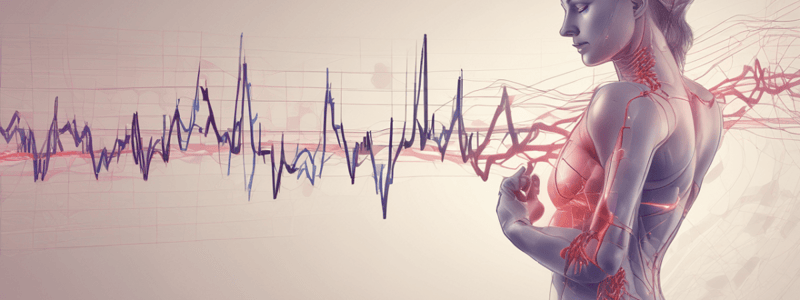Podcast
Questions and Answers
What is the primary factor that determines the sinus rhythm of the heart?
What is the primary factor that determines the sinus rhythm of the heart?
- AV node
- Bundle of His
- SA node (correct)
- Purkinje fibres
What is the effect of increased Ca2+ levels on heart rate?
What is the effect of increased Ca2+ levels on heart rate?
- Increased heart rate (correct)
- Heart rate remains constant
- Decreased heart rate
- No effect on heart rate
What is the term for a heart rate greater than 100bpm?
What is the term for a heart rate greater than 100bpm?
- Tachycardia (correct)
- Hypertension
- Arrhythmia
- Bradycardia
What is the formula to calculate cardiac output?
What is the formula to calculate cardiac output?
What is the normal cardiac output at rest?
What is the normal cardiac output at rest?
Which of the following is a factor that decreases heart rate?
Which of the following is a factor that decreases heart rate?
What is the formula to calculate stroke volume?
What is the formula to calculate stroke volume?
What is the term for the amount of stretch of the ventricles at the end of diastole?
What is the term for the amount of stretch of the ventricles at the end of diastole?
Flashcards are hidden until you start studying
Study Notes
Cardiac Output
- Cardiac output is the amount of blood pumped from the right or left ventricles per minute, calculated by multiplying heart rate and stroke volume.
- At rest, cardiac output is approximately 5L/minute, increasing to around 25L/minute during exercise.
- The cardiac output should meet the body's demand for oxygen and nutrients.
Heart Rate
- The average heart rate in a healthy adult is 60-80 beats per minute (bpm).
- The sinoatrial (SA) node sets the sinus rhythm, which can be influenced by various factors.
- Factors that increase heart rate (positive chronotropic): • Sympathetic nervous system (adrenaline/noradrenaline) signals • Hormones (T3, T4) increasing metabolism • Body temperature • Increased Ca2+ levels • Hypoxia and hypercapnia (low oxygen and high carbon dioxide)
- Tachycardia is a heart rate above 100bpm, while bradycardia is a heart rate below 60bpm.
- Factors that decrease heart rate (negative chronotropic): • Parasympathetic nervous system (acetylcholine) signals • Hyperkalaemia (increased K+ levels) • Decreased Ca2+ levels
Stroke Volume
- Stroke volume is the amount of blood pumped from the left or right ventricles per beat, calculated by subtracting end-systolic volume (ESV) from end-diastolic volume (EDV).
- The stroke volume is influenced by three factors: • Preload: • Amount of stretch of the ventricles at the end of diastole (EDV) • Factors that alter preload: - Venous return - Skeletal muscle pump - Respiratory pump - Venous tone - Gravity • Contractility: • The Frank-Starling Law, which states that the more the heart stretches, the more it contracts.
Studying That Suits You
Use AI to generate personalized quizzes and flashcards to suit your learning preferences.




